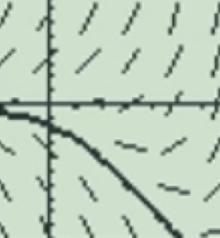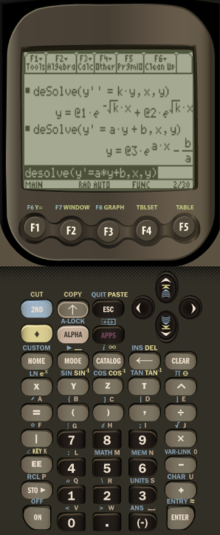TI-89 series
Dot-matrix | |
| Display size | 160×100 |
|---|---|
| CPU | |
| Processor | Motorola 68000 |
| Frequency | 10, 12 MHz |
| Programming | |
| User memory | 256 KB RAM (188 KB user accessible) |
| Firmware memory | 2 MB flash memory (639 KB user accessible) |
| Other | |
| Power supply | 4 AAA batteries, 1 CR1616 or CR1620 for RAM backup |







The TI-89 and the TI-89 Titanium are
TI-89
The TI-89 is a graphing calculator developed by Texas Instruments in 1998. The unit features a 160×100
The TI-89 runs on a 32-bit microprocessor, the
The TI-89 is essentially a
User features
The major advantage of the TI-89 over other TI calculators is its built-in computer algebra system, or CAS. The calculator can evaluate and simplify algebraic expressions symbolically. For example, entering x^2-4x+4 returns . The answer is "prettyprinted" by default; that is, displayed as it would be written by hand (e.g. the aforementioned rather than x^2-4x+4). The TI-89's abilities include:
- Algebraic factoring of expressions, including partial fraction decomposition.
- Algebraic simplification; for example, the CAS can combine multiple terms into one fraction by finding a common denominator.
- Evaluation of trigonometric expressions to exact values. For example, sin(60°) returns instead of 0.86603.
- Solving equations for a certain variable. The CAS can solve for one variable in terms of others; it can also solve systems of equations. For equations such as quadratics where there are multiple solutions, it returns all of them. Equations with infinitely many solutions are solved by introducing arbitrary constants:
solve(tan(x+2)=0,x)returnsx=2.(90.@n1-1), with the@n1representing any integer. - Symbolic and numeric definite integralsare evaluated exactly when possible, and approximately otherwise.
- Calculate greatest common divisor (gcd) and least common multiple (lcm)
- PrettyPrint[6] (like equation editor and LaTeX)
- These mathematical constants are shown as symbols and and and
- Draw 2D and 3D graph[6]
- Calculate taylorpolynomial[7]
- Calculate limit of a function,[8] including infinite limits and limits from one direction
- Vector calculation[9]
- Matrix calculation[10]
- Calculate series[11] (summation or infinite product)
- Calculate chi squared test[12]
- Calculate complex numbers[13][14]
- Factoring polynomial: factor(polynomial) or cfactor(polynomial)
- Solve equation:[15] solve(equation,) or csolve(equation,)
- Solve first or second order differential equation: deSolve(differential equation,,)
- Multiply and divide SI Units:[16] underscore _ "diamond" "MODE"
- A number of regressions:
- LinReg
- QuadReg
- CubicReg
- QuartReg
- ExpReg
- LnReg
- PowerReg
- Logistic
- SinReg
In addition to the standard two-dimensional
Programming
The TI-89 is directly programmable in a language called
.In addition, there is a third party flash application called GTC that allows the writing and compilation of c programs directly on the calculator. It is built on TIGCC, with some modifications. Numerous BASIC extensions are also present, the most notable of which is NewProg.
Since the TI-89's release in 1998, thousands of programs for
. Many calculator games and other useful programs can be found on TI-program sharing sites. Ticalc.org is a major one that offers thousands of calculator programs.Hardware versions
There are four hardware versions of the TI-89. These versions are normally referred to as HW1, HW2, HW3, and HW4 (released in May 2006). Entering the key sequence [F1] [A] displays the hardware version. Older versions (before HW2) don't display anything about the hardware version in the about menu. The differences in the hardware versions are not well documented by Texas Instruments. HW1 and HW2 correspond to the original TI-89; HW3 and HW4 are only present in the TI-89 Titanium.
The most significant difference between HW1 and HW2 is in the way the calculator handles the display. In HW1 calculators there is a video buffer that stores all of the information that should be displayed on the screen, and every time the screen is refreshed the calculator accesses this buffer and flushes it to the display (
HW2 calculators are slightly faster because TI increased the nominal speed of the processor from 10 MHz to 12 MHz. It is believed that TI increased the speed of HW4 calculators to 16 MHz, though many users disagree about this finding. The measured statistics are closer to 14 MHz.
Another difference between HW1 and HW2 calculators is assembly program size limitations. The size limitation on HW2 calculators has varied with the AMS version of the calculator. As of AMS 2.09 the limit is 24k. Some earlier versions limited assembly programs to 8k, and the earliest AMS versions had no limit. The latest AMS version has a 64kb limit. HW1 calculators have no hardware to enforce the limits, so it is easy to bypass them in software. There are unofficial patches and kernels that can be installed on HW2 calculators to remove the limitations.
TI-89 Titanium
SR44 |
The TI-89 Titanium was released in the June 1st, 2004, and has largely replaced the popular classic TI-89. The TI-89 Titanium is referred to as HW3 and uses the corresponding AMS 3.x. In 2006, new calculators were upgraded to HW4 which was supposed to offer increases in RAM and speeds up to 16
The touted advantages of the TI-89 Titanium over the original TI-89 include two times the flash memory (with over four times as much available to the user). The TI-89 Titanium is essentially a
There are some minor compatibility issues with C and assembly programs developed for the original TI-89. Some have to be recompiled to work on the Titanium due to various small hardware changes, though in most cases the problems can be fixed by using a utility such as GhostBuster, by Olivier Armand and Kevin Kofler. This option is generally preferred as it requires no knowledge of the program, works without the need of the program's source code, is automated, and doesn't require additional computer software. In some cases, only one character needs to be changed (the ROM base on TI-89 is at 0x200000, whereas the TI-89 Titanium is at 0x800000) by hand or by patcher. Most, if not all, of these problems are caused by the mirror memory (ghost space) or lack thereof.[citation needed]
Use in schools
United Kingdom
The Joint Council for Qualifications publish examination instructions on behalf of the main examination boards in England, Wales and Northern Ireland. These instructions state that a calculator used in an examination must not be designed to offer symbolic algebra manipulation, symbolic differentiation or integration.[18] This precludes use of the TI-89 or TI-89 Titanium in examinations, but it may be used as part of classroom study. The SQA give the same instructions for examinations in Scotland.[19]
United States
In the United States, the TI-89 is allowed by the College Board on all calculator-permitted tests, including the SAT, some SAT Subject Tests, and the AP Calculus, Physics, Chemistry, and Statistics exams. However, the calculator is banned from use on the ACT, the PLAN, and in some classrooms. The TI-92 series, with otherwise comparable features, has a QWERTY keyboard that results in it being classified as a computer device rather than as a calculator.[20]
See also
References
- ^ "TI-89 Nears Release - ticalc.org". 1998-08-08. Retrieved 2023-01-23.
- ^ "ti89-simulator.org at WI. TI-89 Online Simulator". website.informer.com. Retrieved 2021-05-13.
- ^ Woerner, Joerg (July 27, 2020). "Texas Instruments TI-89". Datamath Calculator Museum. Retrieved June 27, 2022.
- ^ "Chapter 12: Calculator Notes for the TI-89, TI-92 Plus, and Voyage 200". Discovering Advanced Algebra (PDF) (1st ed.). Kendall Hunt. 2004. pp. 73–75. Archived from the original (PDF) on April 7, 2022.
- ^ Fairbourn, Camille. "Using the normalcdf function on the TI‐89" (PDF). Retrieved June 27, 2022.
- ^ a b se side 14 i "Vælg den rigtige regnemaskine. Lommeregnerguide 1998". af Texas Instruments
- ^ "Module 22 - Power Series". TI Education.
- ^ "Finding limits with the TI-89" (PDF).
- ^ "TI 89 for Vectors" (PDF).
- ^ O'Connell, Jeff. "Matrix Operations on the TI-89" (PDF).
- ^ side 14-15 i "Vælg den rigtige regnemaskine. Lommeregnerguide 1998". af Texas Instruments
- ^ Fairbourn, Camille. "Chi-square tests for Independence on the TI-89" (PDF). Retrieved June 27, 2022.
- ^ Brown, Stan. "Complex Numbers on TI-89".
- ^ "How to add vectors on the Ti-89" (PDF).
- ^ McCalla, Jeff; Ouellette, Steve (March 26, 2016). "Solve Command from TI-Nspire CAS Algebra Submenu". TI-Nspire For Dummies. Retrieved June 27, 2022.
- ^ "Calculator Quick Reference Guide and Instructions" (PDF).
- ^ "TI-89 Titanium Now Available - ticalc.org". 2004-06-17. Retrieved 2023-01-23.
- ^ Joint Council for Qualifications (2014). "Instructions for Conducting Examinations 2014–2015". p. 13. Archived from the original on 2015-03-30. Retrieved 2015-03-29.
- ^ Scottish Qualifications Authority (2013). "Mathematics Update Letter" (PDF). p. 2. Retrieved 2015-03-29.
- ^ ACT's CAAP Tests: Use of Calculators on the CAAP Mathematics Test
External links
- Official website
- Instruction Manual
- Using the TI-89 Graphing Calculator
- Complete disassembly of a TI-89 Titanium calculator at the Wayback Machine (archived April 7, 2016)








